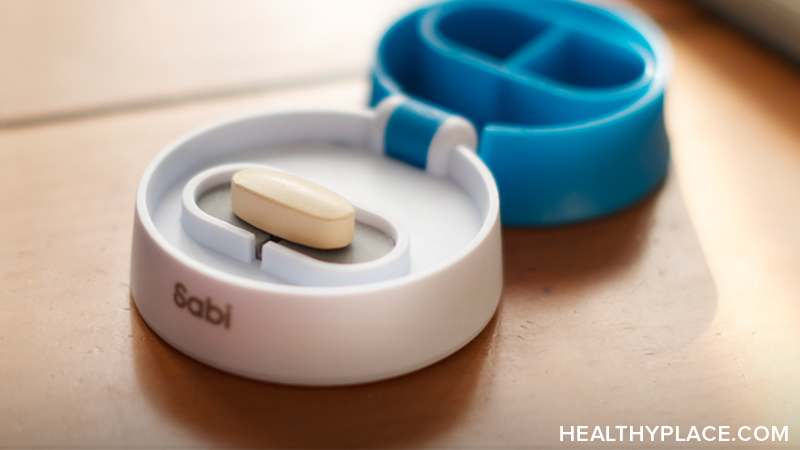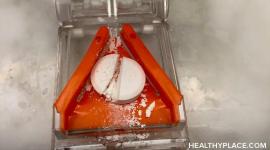The Divide Over Pill-Splitting

Should you cut your antidepressant in half to save money? A look at pill splitting, cutting larger-dose pills in half.
Experts disagree on whether this cost-saving tactic is a safe and effective practice
The cost of some medications -- many of them widely used -- can be reduced by as much as 50 percent when patients split one high-dose tablet in half to achieve the potency of the prescribed lower dose.
It's a way of getting the medication you need at a significant savings. But pill-splitting is also at the heart of the prescription drug debate. Some experts say while it makes sense mathematically -- cutting one high-dose tablet in half to yield the dosage of two lower-strength pills -- they question whether it actually bodes well biochemically: Are patients really getting one-half of the higher dose?
Even as questions abound on do-it-yourself pharmacy, a growing number of studies have begun to show that pill-splitting is a feasible way to treat a wide range of ills and, at the same time, dramatically lower costs.
Picture right: A scored pill inside an EZY Dose Deluxe Tablet Cutter; some drug manufacturers score pills to make them easier to split into roughly equal doses.
"Sometimes, it is medically necessary, and it can be done," said Curtis Kellner, director of pharmacy at the University Hospital and Medical Center at Stony Brook.
Kellner, however, is not a fan of pill-splitting.
Some people have vision problems and can't split tablets, he said. Others have arthritis. "I can't imagine my own folks splitting tablets," Kellner said of his parents.
Cost was the only reason Kellner could find to justify splitting medications. He could see no sound medical reasons to endorse the practice.
But pill-splitting is catching on as more and more patients and insurers turn to it to beat back the rising cost of prescription drugs.
The idea behind pill-splitting stems from the way in which prescription drugs are made and priced. Many tablets are "scored," meaning they have a line running through the middle. When patients purchase the higher dose of their prescribed medication, cutting tablets along the score essentially yields two lower doses.
Tom Johnson, a pharmacist at Jones Drug Store in Northport, said pills are purposely scored by manufacturers. "This makes it easier for patients to take a lower dose," he said. "Midway through therapy, the doctor may decide the patient needs only a half dose. In that case, a patient can use a pill cutter to lower the dose." The score line through the tablets was added to help patients save money. However, pharmacists and physicians emphasize that patients should be trained in pill-splitting before they attempt it.
Some tablets should not be scored because they have extended-release properties built into their design. In fact, tablet function often dictates design, said pharmacist Vincent Terranova, also of Jones Drug Store. Having a drug remain active for 12 to 15 hours is vital in the treatment of several medical conditions.
While scoring does not interfere with the activity of dozens of types of medications, breaking pills that are not designed that way can destroy properties in the coating, resulting in too much or too little medication.
"Years ago, you might have gotten a prescription to take one tablet four times a day; now, you don't have to do that. You may take one capsule daily or two times a day," the result of extended-release properties in nonscored tablets.
"Every few hours, medication is released in a certain amount. If you break that tablet, you will interfere with the extended-release mechanisms," Terranova said.
Many -- but not all -- drugs that are scored can be cut in half. Patients can split pills, using a special blade that can be purchased at pharmacies for $5 to $10.
The practice becomes an economic strategy, some experts say, because the lower and higher strengths of any given medication usually cost about the same. For example, at drugstore.com, 30 10-milligram tablets of the antidepressant Paxil cost $72.02. The same amount of tablets in the 20-milligram dose sells for $76.80. With pill-splitting, patients can get twice as much medication for only a few dollars more.
Additionally, doctors have identified all manner of tablets that can be split: those that impede pain, those for high cholesterol, depression, hypertension, and male erectile dysfunction, to name a few.
Medications, like the antidepressant Celexa, generically known as citalopram hydrobromide, are so deeply scored on both sides, that a 40-milligram tablet can be easily snapped in half by hand to yield the lower, 20-milligram dose, doctors say.
Medical experts who favor pill-splitting say people have been doing it for years. "This is a practice that has been present at a low level for a very long time," said Dr. Randall Stafford, a professor of medicine at Stanford University Medical Center in Palo Alto, Calif.
Stafford, who led a major study on the feasibility of pill-splitting, said the practice renders high-cost medications imminently affordable. And he believes it is an idea worth considering by anyone lacking prescription-drug insurance coverage. He and his team identified a range of medications that could be safely split to yield a cost savings.
"The potential cost savings with pill- splitting are not trivial," Stafford said, "and are in the range of $25 a month for most of the drugs we identified." In his investigation, Stafford identified 11 commonly used medications that could be safely split.
Increasingly, patient advocacy groups, insurers and health maintenance organizations have begun to embrace the practice. The Veterans Administration permits pill-splitting for its patients, as does Kaiser Permanente, the largest health maintenance organization in the country.
The Illinois Medicaid program now requires patients who receive prescriptions for the 50-milligram dosage of the antidepressant to buy the 100-milligram tablets instead, and split them in half. This instantly doubles the number of tablets patients have available at about the same cost of the 50-milligram pills. Illinois Medicaid reimburses patients only for the higher-dose tablets.
However, the American Medical Association, the American Pharmaceutical Association and the American Society of Consultant Pharmacists have openly opposed mandatory pill-splitting by insurers. They cite potential underdoses or overdoses of drugs as a consequence.
A recent report in the Journal of the American Pharmaceutical Association on splitting nearly a dozen commonly used drugs, found the practice rests on the cutter's ability to accurately halve the medication. Most people tested, the study found, could neither accurately nor safely split the drugs.
John Broder, spokesman for Winthrop University Medical Center in Mineola, said neither pharmacists nor doctors there recommend the practice. However, pill-splitting is endorsed in instances when hospital physicians prescribe a dosage that is not available commercially.
"The emphasis here is that individuals should not take it upon themselves to split a dosage to make a prescription last longer," Broder said.
But patients, some doctors say, are expressly asking to be informed about the benefits and drawbacks of pill-splitting.
"The issue of pill-splitting first came to my attention," Stafford continued, "because patients came to me requesting it. By and large, these were patients who did not have insurance coverage for their medications."
Kellner, however, is more concerned about what patients obtain after they split their pills.
"There are other issues people have to be concerned with," Kellner said. Some drugs are film-coated, he said, and must remain intact to be properly absorbed. Still others, he said, are oddly shaped and cannot be split to yield two effective doses.
, Pfizer's small blue pill for male erectile dysfunction, is so small that a special splitter has been developed to permit patients to cut the dose in half.
Nevertheless, Kellner still sees a problem with splitting small tablets, especially those developed to treat serious maladies. "Even though digoxin is scored," he said of the drug also known as digitalis and prescribed for heart failure, "it is too tiny to safely split. So if you're going to endorse tablet-splitting, you'll also have to set rules about which tablets can and cannot be cut. With digoxin you'd wind up with two little crumbs."
He also emphasized that tablets do not contain the exact amount of medication in the two halves, a fact already well known by health officials at the Food and Drug Administration. People who need an exact dose of their medication could fall far short because of the way a tablet is manufactured, Kellner said.
Rather than patients splitting their pills at home, Kellner said he'd prefer to see an end to what he calls "predatory pricing" by pharmaceutical companies.
"Drugs are becoming more and more a significant cost of health care, and it is a tremendous problem," Kellner added. "Drug budgets of hospitals have more than doubled in the last couple of years because of the cost of pharmaceuticals."
But researchers such as Stafford say patients need relief from the costs. "We're not advocating this as a global solution," Stafford said of drug-splitting. "It needs to be conducted within the context of a doctor-patient communication." He highly recommends that anyone considering the practice use only a special pill-cutting blade and to be trained by a pharmacist in its use.
Stafford acknowledges that many groups of patients are not even candidates for the practice: those with poor eyesight, severe arthritis affecting their hands, dementia or psychosis.
But Stafford's analysis also revealed the dramatic sums that can be saved with drug-splitting. He and his team assessed the costs of a Massachusetts-based health plan before wide-scale pill-splitting and what could be saved if it were endorsed.
Only a few doctors in the plan encouraged the practice prior to the study and did so infrequently. The result was an average cost savings of $6,200 for the insurer. If, instead, the plan pushed pill-splitting for the 11 medications Stafford identified as safe to cut, the plan would save $259,500 a year.
The practice can prove equally dramatic for individuals. Stafford found, for instance, that patients prescribed the 10-milligram tablets of Zestril for congestive heart failure can realize a significant savings by buying the 20-milligram strength and splitting the pills.
For the 10-milligram strength, the cost is about $340 a year Stafford estimated. By cutting the 20-milligram tablet in half, the cost would be only $180, Stafford said.
Warning: Do not make any changes in your medications or the way you take your medications without first talking it over with your doctor.
Source: Newsday - Nov. 19, 2002
APA Reference
Staff, H.
(2022, January 4). The Divide Over Pill-Splitting, HealthyPlace. Retrieved
on 2025, November 27 from https://www.healthyplace.com/depression/antidepressants/divide-over-pill-splitting



